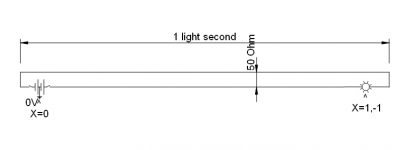OK, so a few questions from the video, in reference to the diagram below.
The symbol on the left, that just represents "ground" and just means the point we will use as the 0V reference, yes? Let's assume that instead the 0V point is at the left end of the battery, and the battery is 1V with no internal impedance, and the battery and switch are basically a point.
Say the left-right extent of the wires is 1 light second, and define a coordinate x in light seconds that's 0 at the upper left, and increases as you go around the loop clockwise. So x=2 is the same point as x=0, we'll say the wires are a constant distance apart that is near 0. Say that the battery and switch are located at x = 1/4, and say we instantaneously close the switch at time t=0. Say that the transmission line impedance of the pair of wires is 50 ohms as in the video.
I'd like to know the functions V(x,t) and I(x,t) for voltage and current between t=0 and the steady state, for all points on the loop. Starter questions:
A) So V(x,0) = 0 except V(1/4,0) =1, right? I'm thinking of the short segment of wire between the battery and the switch and calling that the point x=1/4. I(x,0) = 0 for any x.
B) How about V(x,1/8)? I think it's 1 for 1/4 <= x <= 3/8, and 0 elsewhere, is that right? The video talks about two way propagation, but I don't see how anything is propagating CCW from the battery when it's all at 0V to start.
C) How about I(x,1/8)? The video talked about a displacement current of 20 ma caused by the change in voltage. At t = 1/8 , where exactly along the loop is the current 20ma, and where is it 0? I think on the basis of the speed of causality, I(x,1/8) has to be 0 except for a subset of (1/8,3/8) and (1 5/8, 1 7/8).
Cheers, Wayne
View attachment 2558596



